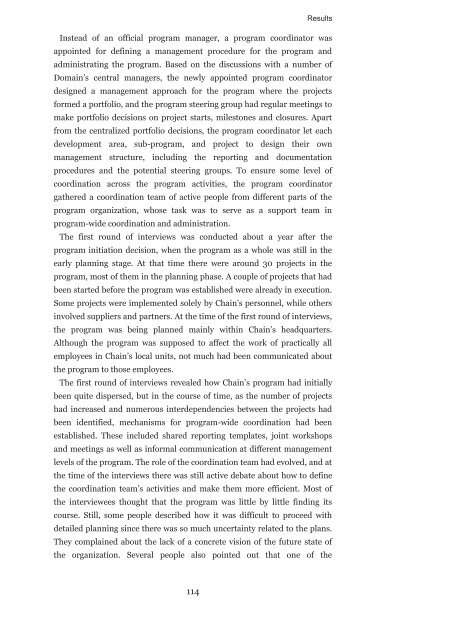Boundary activities and readiness for ... - Projekti-Instituutti
Boundary activities and readiness for ... - Projekti-Instituutti
Boundary activities and readiness for ... - Projekti-Instituutti
You also want an ePaper? Increase the reach of your titles
YUMPU automatically turns print PDFs into web optimized ePapers that Google loves.
Results<br />
Instead of an official program manager, a program coordinator was<br />
appointed <strong>for</strong> defining a management procedure <strong>for</strong> the program <strong>and</strong><br />
administrating the program. Based on the discussions with a number of<br />
Domain’s central managers, the newly appointed program coordinator<br />
designed a management approach <strong>for</strong> the program where the projects<br />
<strong>for</strong>med a portfolio, <strong>and</strong> the program steering group had regular meetings to<br />
make portfolio decisions on project starts, milestones <strong>and</strong> closures. Apart<br />
from the centralized portfolio decisions, the program coordinator let each<br />
development area, sub-program, <strong>and</strong> project to design their own<br />
management structure, including the reporting <strong>and</strong> documentation<br />
procedures <strong>and</strong> the potential steering groups. To ensure some level of<br />
coordination across the program <strong>activities</strong>, the program coordinator<br />
gathered a coordination team of active people from different parts of the<br />
program organization, whose task was to serve as a support team in<br />
program-wide coordination <strong>and</strong> administration.<br />
The first round of interviews was conducted about a year after the<br />
program initiation decision, when the program as a whole was still in the<br />
early planning stage. At that time there were around 30 projects in the<br />
program, most of them in the planning phase. A couple of projects that had<br />
been started be<strong>for</strong>e the program was established were already in execution.<br />
Some projects were implemented solely by Chain’s personnel, while others<br />
involved suppliers <strong>and</strong> partners. At the time of the first round of interviews,<br />
the program was being planned mainly within Chain’s headquarters.<br />
Although the program was supposed to affect the work of practically all<br />
employees in Chain’s local units, not much had been communicated about<br />
the program to those employees.<br />
The first round of interviews revealed how Chain’s program had initially<br />
been quite dispersed, but in the course of time, as the number of projects<br />
had increased <strong>and</strong> numerous interdependencies between the projects had<br />
been identified, mechanisms <strong>for</strong> program-wide coordination had been<br />
established. These included shared reporting templates, joint workshops<br />
<strong>and</strong> meetings as well as in<strong>for</strong>mal communication at different management<br />
levels of the program. The role of the coordination team had evolved, <strong>and</strong> at<br />
the time of the interviews there was still active debate about how to define<br />
the coordination team’s <strong>activities</strong> <strong>and</strong> make them more efficient. Most of<br />
the interviewees thought that the program was little by little finding its<br />
course. Still, some people described how it was difficult to proceed with<br />
detailed planning since there was so much uncertainty related to the plans.<br />
They complained about the lack of a concrete vision of the future state of<br />
the organization. Several people also pointed out that one of the<br />
114









